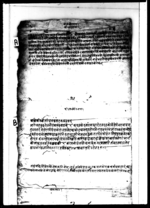A copy of an executive order from Cautariyā Bam Sāha empowering Rāmānanda Bā̃ḍā to operate the Luthāma Guṭha (VS 1859)
ID: E_2253_0015B
Edited and
translated by Manik Bajracharya
in collaboration with
Yogesh Budathoki
Created: 2020-08-18;
Last modified: 2020-11-24
For the metadata of the document, click here
The accompanying edition, translation/synopsis and/or commentary are available under the terms of the Creative Commons Attribution-ShareAlike 4.0 International License
Abstract
This copy of an executive order of Cautariyā Bam Sāha empowers Rāmānanda Bā̃ḍā of Patan to operate the Luthāma Guṭhī, a trust responsible for maintaining the decorative gilt metal panels that secure the sanctum of the Matsyendranātha chariot. The guṭhī was founded by Rāmānanda's ancestor Jivarāja Bā̃ḍā, and oversheership of it was fraudulently retained by Bhājudhana Jaisī at the beginning of the 19th century.Diplomatic edition
[1r]
1श्री३मत्स्येंद्रनाथ१1स्वस्तिश्रीमच्चौतरियावम्वसाहकस्यपत्रम्¯¯¯ ¯¯¯ ¯¯¯ ¯¯¯ ¯¯¯ ¯¯¯2आगे•महावुद्दटोलकोरामानंदवाडाके¯ ¯१¯कागूठको•इजारामाफगरिराजगूठकोविसेटिभारामात्रभा
3जुधनलाई•मोहोरगरिदियाकोहो•वाडालेराष्याकोलुथामगूठहोभनिभाजुधनलेवेओंरानकहँदा•मोहो
4रमहाँपर्याकोलुथामगूठछतपनि•प्रजा[...][...]रिभाजुधनजैसिलाइदियाकोछैन•तिम्रापुरुषालेराष्या
5कोगूठ•वीचमहाइजारापर्दा•तिमिलेषेतछाडि•कामनछाड्याकारह्याछौ•परंपराकारीतलेगरिआया
6कोआफ्नापुरुषालेचढायाको¯ ¯१¯कारथकोवित्तशिल्पमाफिक•मरमतगरि•जीवराजवाडालेच
7ढायाकोगूठजानिचलनगरइतिसंवत्१८५९श्रावणशुदि५रोज३शुभम्¯¯¯ ¯¯¯ ¯¯¯ ¯¯
1तांहांपछि•विंतिगर्यौं•वोकाकाटि•वोकालाई•वलिदिनुहुन्न•एकाप्रजाकोगूठ•अर्काप्रजालाई•क्या
2नहोलाभनि•वेओरावुझि•मोहोरगराई•हाम्रापुरुषाकोगूठहाम्राहातचलनदियाकोमोहोरकोनकल्
Translation
[1r]
Thrice glorious Matsyendranātha - 1
Hail! A letter of venerable CautarīyāBamba Sāha.
Āge: to Rāmānanda Bā̃ḍā of Mahābuddha Ṭola. Having forgiven ijārā [obligations on the part of] the guṭha of 1 [i.e., Matsyendranātha], we had issued a mohara to Bhājudhana granting him merely the responsibility of a biseṭ1 of the [Matsyendranātha] rājaguṭha2 . Bhājudhana did not reveal the information that the Luthāma Guṭha was established by the Bā̃ḍās. Therefore, [that] mohara includes the Luthāma Guṭha [within the remit]. However, we have neither confiscated [this] guṭha founded with private land (prajāguṭha), nor have we passed it on to Bhājudhana Jaisi. It is learned [from your letter] that when this guṭha, established by your ancestors, fell under the ijārā [system], you gave up the lands but not [your] duties. By following the traditional customs and using your wealth [and] skills (vitta śilpa), maintain the [vimāna3 of] the chariot of Matsyendranātha donated by your ancestors. Knowing that the guṭha was donated by Jīvarāja Bā̃ḍā, enjoy [its fruits]. Tuesday, the 5th of the bright fortnight of Śrāvaṇa in the [Vikrama era] year 1859 (1802 CE).
We then made a petition [to the king]. "A he-goat cannot be sacrificed to another he-goat. How can the guṭha of one subject be [given] to another subject?" [He] understood and had a mohara issued. Below is a copy of the mohara that put the operation of the guṭha of our ancestors back into our hands.4
Commentary
This letter was sent by Bam Sāha in response to a petition by Rāmānanda Bā̃ḍā of Mahābuddha in Patan (see document E_2253_0015A for the background to the petition). This is the second document of the series concerning a legal issue over the overseership of the Luthāma Guṭhī fraudulently retained by Bhājudhana Jaisi.
The document mentions that Bhājudhana was appointed a biseṭ of the rājaguṭhī that concerned with Matsyendranātha. Owing to his nondisclosure of the guṭha's origins, the Luthāma Guṭha came under his control, even though it was not in fact a rājaguṭhī. The document acknowledges this mistake and allows Rāmānanda to take back charge of it.
The document contains a note at the end which indicates that Rāmānanda made petition to the king, and that he was able to obtain a lālamohara confirming his clan's overseership of the guṭhī endowments. A copy of this lālamohara is available: E_2253_0015C.
There is another copy of this document in E_2254_0001A. Except for an invocation श्रीदुर्गासहाय:\ (missing here) and the reading श्रीमत्स्येन्द्रनाथ१ (instead of श्री३मत्स्येन्द्रनाथ१ here) both this and E_2254_0001A are exactly the same. Similarly, the scribal note at the end of this document is comparable to E_2254_0001B with some additional sentences.

